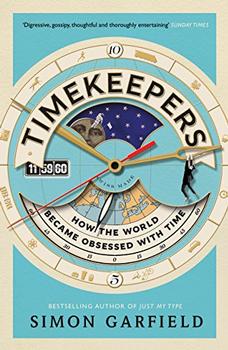Summary | Excerpt | Reviews | Beyond the Book | Readalikes | Genres & Themes | Author Bio

Critics' Opinion:
Readers' Opinion:
First Published:
Jan 2018, 368 pages
Paperback:
Dec 2018, 368 pages
 Book Reviewed by:
Book Reviewed by:
Rory L. Aronsky
Buy This Book
Passengers who prided themselves on the accuracy of their watches (and as the century grew on, there were many more of these) were joined by an entirely new watch-owning class - railwaymen. Neither would be satisfied with what they saw as unnecessary wrinkles in precision. If railway station clocks were left unsynchronized, composite and comparable timetables between destination and arrival points would not only cause confusion and frustration, but would be increasingly impossible and dangerous to maintain. As railways filled the countryside, a driver's watch at variance with another's would almost certainly end in collision. And then a year later, a solution was found, at least in Britain. For the first time, timekeeping achieved nationwide standardization: the railways began to imprint its own clock upon the world.
In November 1840 the Great Western Railway was the first to adopt the idea that time along its route should be the same no matter where a passenger alighted or departed. This task was made possible with the advent of the electric telegraph the year before, with time signals from Greenwich being sent directly along trackside wires. 'Railway Time' thus regulated itself with 'London Time', and by 1847, it was running on the North Western Railway (where its greatest champion was Henry Booth), the London and South Western, the Lancaster and Carlisle, South Eastern, Caledonian, the Midland and the East Lancashire lines.
There were other maverick champions too. In 1842, Abraham Follett Osler, a glassmaker and meteorologist from Birmingham, believed so strongly in the establishment of standardized time beyond the railways that he took matters into his own hands. Having raised funds for the erection of a new clock outside the Birmingham Philosophical Institution, he proceeded one evening to change its time from local to London time (moving it 7 minutes and 15 seconds forward). People noticed, but they also admired the clock's accuracy; within the course of a year, local churches and shopkeepers changed their time to match it.
By mid-century, about 90 per cent of Britain's railways were running London time, although the regulation met a little local opposition. Many city officials objected to any interference from London, and showed their disapproval by maintaining clocks with two minute hands – the later one usually denoting their local, older time. In an article titled 'Railway-time Aggression', a correspondent in Chambers's Edinburgh Journal in 1851 offered comical disgust: 'Time, our best and dearest possession, is in danger. [Inhabitants were] now obliged, in many of our British towns and villages, to bend before the will of a vapour, and to hasten on his pace in obedience to the laws of a railway company! Was ever tyranny more monstrous or more unbearable than this?' The writer backs his disdain with many examples, including a dinner party and a wedding both ruined as a result of time discrepancies, before rallying the readership: 'Is it possible that this monster evil, with its insidious promises of good and its sure harvest of evil, will be tolerated by freeborn Englishmen? Surely not! Let us rather rally round Old Time with the determination to agitate, and, if needs be, to resist this arbitrary aggression. Let our rallying cry be "The Sun or the Railway!" Englishmen! Beware of delay in opposing this dangerous innovation! No time is to be lost – "Awake, arise, or be forever fallen!" '
Railway Time could kill you just by being there. In 1868, one Dr Alfred Haviland, an epidemiologist and author of the guide Scarborough as a Health Resort, published Hurried To Death: or, A Few Words of Advice on the Danger of Hurry and Excitement Especially Addressed To Railway Passengers, in which, in fairly breathless prose, he warned of the risks of over-studying of a train timetable and running to catch a departure, and being overly concerned with the era's new schedules. His evidence, which managed to be both conclusive and dubious, centered on research suggesting that those who ventured regularly on the Brighton to London line aged faster than those who didn't.
Excerpted from Timekeepers by Simon Garfield. Copyright © 2017 by Simon Garfield. Excerpted by permission of Canongate Books. All rights reserved. No part of this excerpt may be reproduced or reprinted without permission in writing from the publisher.





The House on Biscayne Bay
by Chanel Cleeton
As death stalks a gothic mansion in Miami, the lives of two women intertwine as the past and present collide.

The Flower Sisters
by Michelle Collins Anderson
From the new Fannie Flagg of the Ozarks, a richly-woven story of family, forgiveness, and reinvention.

The Funeral Cryer by Wenyan Lu
Debut novelist Wenyan Lu brings us this witty yet profound story about one woman's midlife reawakening in contemporary rural China.
Your guide toexceptional books
BookBrowse seeks out and recommends the best in contemporary fiction and nonfiction—books that not only engage and entertain but also deepen our understanding of ourselves and the world around us.